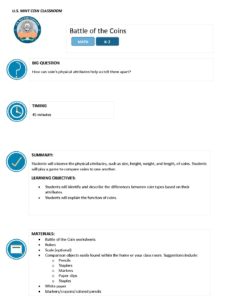Summary
Objectives
- Students will observe the physical attributes, such as size, height, weight, and length, of coins.
- Students will play a game to compare coins to one another.
Subject Area
- Math
Grades
- K
- 1st
- 2nd
Class Time
- Total Time: 0-45 Minutes minutes
Materials
- Battle of the Coin Worksheet
- Rulers Scale (optional)
- Comparison objects easily found within the home or your class room. Suggestions include:
- Pencils
- Staplers
- Markers
- Paper clips
- Staples
- White paper
- Markers/crayons/colored pencils
Lesson Steps
1. Review information about coins using real coins, circulating coin pages on www.usmint.gov/kids, or other sources.
-
- Be sure to discuss the 4 kinds of U.S. circulating coins: penny, nickel, dime, quarter.
- Prompt students to discuss what coins are used for and where they might find coins (e.g., change jar, piggy bank)
2. Write down responses on the board, a virtual whiteboard, or chart paper titled "What We Know About Coins." 3. Break up the class into 5 groups and ask students to sit together. If teaching virtually, create 5 breakout groups to be used in the next part of the lesson.
Group Work: Coin Physical Attributes (20 minutes)4. Assign each group a coin (penny, dime, nickel, quarter, dollar). Hand out the Battle of the Coin worksheet and a ruler to each student. Give each group items for comparing weight and size such as staples, paper clips, markers, pencils, and erasers.
5. Explain that each group will work together to complete the card for their assigned coin and then share with the class. Demonstrate using the Kennedy Half Dollar. Measure the coin using a ruler and write on the length on the card. If you have access to a scale, weigh the coin and write in the weight. If you do not have access to a scale, you can use the Coin Specification Table on usmint.gov to find the weight. Compare the coin to another classroom object and complete the sentences on the card. Ask the class to complete their Kennedy Half Dollar card based on the demonstration.
6. Ask each group to fill in their coin card. Observe each group and provide help where needed. When each group is finished, check their responses and correct any mistakes or errors.
7. After each group has completed their card, invite the groups to share what they wrote in each blank, one at a time. Ask the rest of the groups to write in the responses being shared by the other groups so that each student will have completed cards for each card.
8.After students have filled in their cards, instruct them to cut out the cards and put them into a pile.
Play Battle of the Coins (30 minutes)9. When students have their cards cut out an in a pile, explain that we will use the cards to play a game. 10. Ask students to get into pairs and to hold onto their Coin Cards. 11. Explain the rules of the game. In each round, students will hold their card pile or place it on the desk/table face down. Then, they'll pick one card to play against the partner's card, similar to the card game War. Students will only play their card once they hear you call for them to play. To start the game, you will call out and write on the board / project one attribute that the students will use to compare their cards (e.g., bigger, smaller, lighter, heavier, or least or most valuable). If you call out "Bigger," the student with the coin card that is bigger will collect both cards. To check students' understanding, after a round, ask each pair to share which coin card won and lost the round. Continue playing until one student in each pair has all the cards. You can continue playing by asking students to mix up and redistribute the cards. 12. You can make this game more challenging by asking students to remove all the coin cards of one coin (e.g., penny) or asking students to play in groups of three instead of two.
Differentiated Learning Options
- Ask students to create their own coin cards to add into the deck. They can assign the coins adifferent value, draw their coin on the card, and then continue playing Battle of the Coins.
- Set up students to do a lightening round where you call out an attribute and they play 3 hands in a row instead of just one.
- Play a progressive battle: In this variation, students walk around with their cards and battle one student when you call out to play. When one student wins a battle, the loser joins the winner's team as a cheerleader. The winner then finds another student, who also won the last hand, to play. Continue playing like this until there are just two players left and one student wins the entire game.

